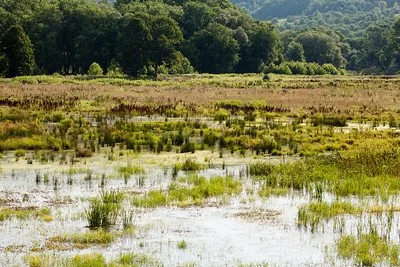The PERMIT Act: Speed vs. Transparency in Wetland Protection
Congress is considering the PERMIT Act (H.R. 3898), which would make significant changes to Clean Water Act permitting.
Please note that we have only reviewed three sections of the bill (12, 13, and 15) that propose changes to how wetland permits work. Readers interested in changes to NPDES permits, water quality standards, 401 certification, agriculture and pesticide exemptions, and other CWA matters should review the full text of the bill.
Below, I summarize the streamlining solutions proposed and where the bill goes wrong.
Photo credit: Restored wetlands in Chenango County, N.Y., Chesapeake Bay Program
Section 13: Expanding Nationwide Permits
Streamlining Solution Proposed: Expand General Permits
The Corps of Engineers uses general permits including nationwide permits (NWPs) and regional permits to streamline wetland and stream permitting under section 404 of the Clean Water Act. For projects with minimal adverse individual and cumulative environmental effects, one permit covers all activities within a category &/or geographic region rather than having each project permitted through a lengthier ‘individual permit.’ There is a faster timeline (e.g., 1-3 months rather than a year or more) to determine that the project falls within the category.
EPIC generally supports general permits, but there’s a flaw in the Corps’ NWP program - that there is little transparency and evaluation which is a major issue in light of continuing losses of aquatic resources. This was recently documented in the 2024 decadal US Fish and Wildlife Status and trends of wetlands in the conterminous United States 2009 to 2019 (Lang et al. 2024).
What is permitted under NWPs, where NWPs are permitted, and the geographic cumulative impact of these permits (aside from the national RIA) is not readily available to the public. The only publicly-available cumulative impact analysis of the potential impacts of NWPs are within the Regulatory Impact Analysis of the NWP program as a whole, provided every 5 years during reissuance but not readily accessible to the public.
The Corps essentially asks us to trust that these permits have minimal impacts without showing us where they are or how much impact they add up to.
Where the bill goes wrong:
The bill’s proposal to extend the period of NWPs from 5 to 10 years means that the public has even less insight into the impacts of permits, and opportunity for public input and course correction. As we’ve noted in a recent comment letter, this deficiency in transparency could be greatly alleviated by making the Corps’ internal 404 cumulative impacts tool publicly available.
The bill’s proposal to cover more projects under the general permit (NWP program) by expanding the threshold of impact allowed from .1 acres of wetlands / .003 acres of streams to 3 acres means the public is asked to trust that these permits have minimal individual and cumulative environmental impact - despite a lack of verification and evidence to the contrary (Lang et al. 2024). Expanding the thresholds further undermines this already unstable foundation of trust, especially without transparency of actual outcomes.
Section 15: New Restrictions on Judicial Review
Streamlining Solution Proposed: Reduce Late Litigation and Questionable Standing
The bill introduces litigation restrictions aimed at reducing perceived NIMBY-ism and frivolous lawsuits. While research on NEPA litigation seems all the rage (one can easily find a bevy of studies from the last 5 years), frequency &/or severity of ‘egregious’ litigation on CWA 404 individual or general permits is lacking. This raises questions about whether the proposal addresses a real problem or is solving for a non-issue.
Where the bill goes wrong:
Aside from potentially addressing a boogeyman problem, the bill goes too far in restricting the timeframe of when someone can litigate as compared to other permit streamlining bills. This bill requires a request for judicial review to be filed within 60 days after permit issuance, whereas the Westerman (R) and Golden (D) SPEED Act (Standardizing [NEPA] Permitting and Expediting Economic Development) gives 150 days. Both bills make reference to restricting lawsuits to parties who “substantively commented” during the public comment period (comment periods exist for individual permits but not for NWPs so I don’t know how a person can get standing in the case of NWPs), and the lawsuit must be related to that comment.
Section 12: Limiting EPA's Veto Power
Streamlining Solution Proposed: Interagency Coordination
EPIC supports interagency coordination as a means to streamline permit reviews, and this can include designating one agency in the main ‘decider’ role, as we applauded in Corps’ leadership memos from September 2024. CWA 404 permits are issued by the Corps of Engineers, but EPA maintains significant oversight authority over the program. This bill limits the EPA’s ‘veto’ authority on Clean Water Act permit decisions. A quick search finds EPA has “used its Section 404(c) authority very sparingly, issuing only 14 final determinations since 1972.”
Where the bill goes wrong:
The bill’s proposed changes are a hammer for very infrequent nails (e.g., times when EPA exercises its veto authority). The EPA has vetoed only 3 projects over the last 20 years: the Pebble copper-gold mine in Alaska, Spruce coal mine in West Virginia, and Yazoo pumps project in Mississippi. This suggests that the proposed change is more about settling bad beef between proponents of these specific projects and the EPA than addressing systemic problems. There are likely better policy and legislative options for addressing individual, infrequent problems than changing the text of the statute itself.
A Better Path Forward
Real permitting reform should focus on eliminating inefficiencies while strengthening the core intended outcomes of the law. This means better data and ePermitting systems, automated completeness checks, and transparent tracking of permit decisions.
The PERMIT Act moves in the wrong direction by prioritizing speed without transparency and accountability. We can do better.
See more on EPIC's smart permitting recommendations.


